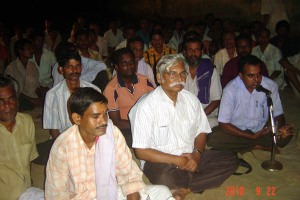Any attempt to distort history of Khandua must be condemned as an offense against cultural heritage, said eminent journalist and culture scholar Subhas Chandra Pattanayak in a mass meeting in Tigiria’s Nuapatana on September 22. Tigiria is Sri Pattanayak’s native place.
The meeting was held in evening to protest against recent attempts by a vested interest section of weavers of Maniabandh village belonging to the neighboring Tahsil of Baramba in the district of Cuttack to mislead the state about Khandua heritage.
 Bhagirathi Nanda, President, Orissa Cooperative Tasar and Silk Federation Ltd (SERIFED) who on 7 July 2009 had apprised the Controller of Geographical Indication Registry of origin and development of Khandua in Nuapatana, conducted the meeting.
Bhagirathi Nanda, President, Orissa Cooperative Tasar and Silk Federation Ltd (SERIFED) who on 7 July 2009 had apprised the Controller of Geographical Indication Registry of origin and development of Khandua in Nuapatana, conducted the meeting.
 Sri Pattanayak quoted and analyzed various sources in which Nuapatana of Tigiria is recognized as the place of origin of Khandua. Recalling his childhood days he said, Maniabandh was known for manufacture of a peculiar pattern of Dhoti and Chadar Called Maniabandhi Joda. The only Sharee Maniabandh was producing was known in the locality as Chagla Sharee. Khandua was Nuapatana’s exclusive product.
Sri Pattanayak quoted and analyzed various sources in which Nuapatana of Tigiria is recognized as the place of origin of Khandua. Recalling his childhood days he said, Maniabandh was known for manufacture of a peculiar pattern of Dhoti and Chadar Called Maniabandhi Joda. The only Sharee Maniabandh was producing was known in the locality as Chagla Sharee. Khandua was Nuapatana’s exclusive product.
Linking the history of Khandua to history of Sri Jagannatha, Sri Pattanayak recalled how Ramachandra Dev –ii, the Gajapati emperor of Orissa, in a court-order in 1641 Saka, had asked the King of Tigiria to prevail upon eight weaver-brothers of Tigiria (Nuapatana) to supply Khandua to Srimandira for use by Sri Jagannatha in lieu of which he had offered to appoint them as Patra Sevakas of the Lord. This being recorded by the Madala Panji is a conclusive proof of Khandua being manufactured only in Nuapatana in Orissa. As far back as on 18th September 1813, a list of cloths kept for use by Sri Jagannatha, Balabhadra and Subhdra was prepared by the British, Khandua mentioned in this list is noted as (Nua) Putnee Khandooa, There is no mention of Maniabandh in respect of Khandua in this list, said Sri Pattanayak.
Recalling his childhood memories, Sri Pattanayak disclosed how legendary artist Bibhuti Kanungo had stayed in Nuapatana in the house of Arjuna Subudhi for months together to learn the technique of Khandua weaving. Later as he transmitted that technique to Sambalpuri weavers, he was issued with a communication of appreciation by the central government.
Quoting sources he said, Khandua and Bandha Padavali textiles found in public museums in India and abroad so far are from Tigiria (Nuapatana) only; not from Maniabandh.
So, evidently, Nuapatana of Tigiria is the habitat of the creators of Khandua. It is an offense against history to claim originality in manufacturing of Khandua by weavers of any other locality, said Sri Pattanayak.
